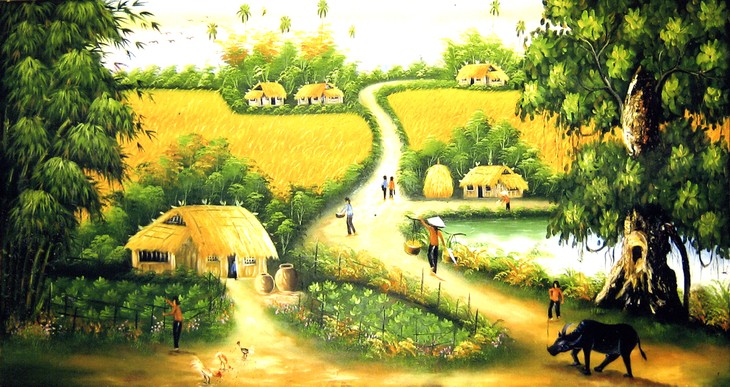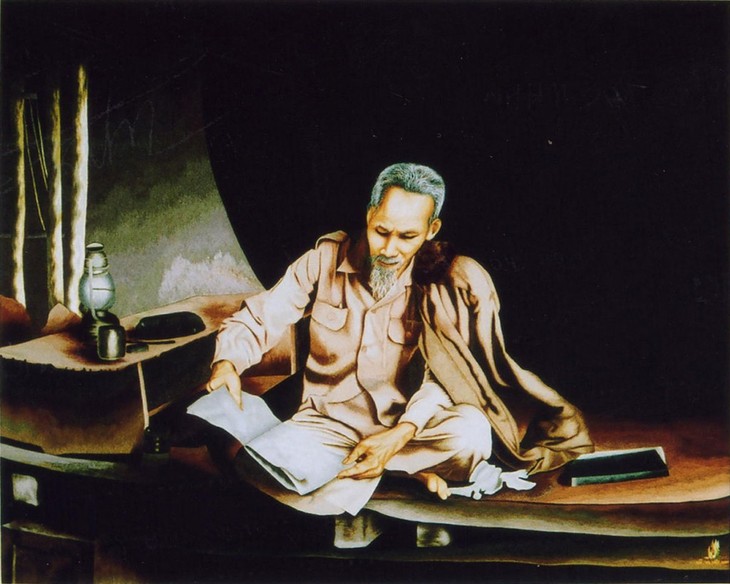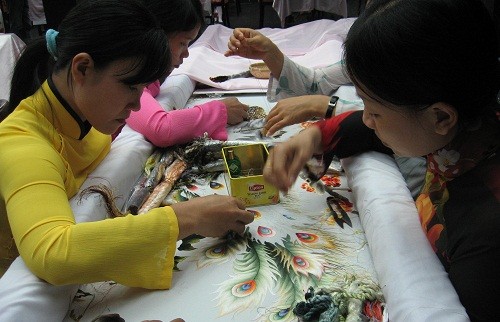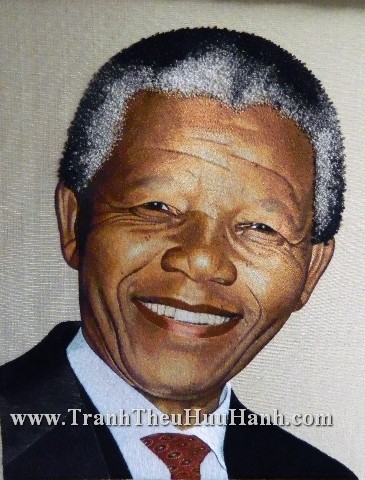(VOVworld) - This week, we got an email from Arvid Husdal, a 49-year-old radio enthusiast from Kristiansand in the far south of Norway. He said his hobby is Dx-listening and monitoring the shortwave and medium radio communications of far away stations from across Europe and other parts of the world.
B: Arvid reported listening to VOV’s programs in Vietnamese and Chinese on 729khz on October 19, 2015. We’ve listened to your audio attachments and forwarded them to the Vietnamese and Chinese sections to process.
A: We have added your address to our contact list. We hope to correspond regularly from now on. We’re looking forward to receiving your feedback on VOV’s English program soon.
B: This week we continue to receive technical reports from some listeners. Gerry Neumann from England wrote: “For the second time in three days, the transmitter on 9625 khz beamed to Europe at 17UTC opened as normal around 16:59 on Wednesday August 17, but the broadcast did not begin. Instead the transmitter remained open without any programs. On Tuesday August 16 there were many fade-outs during the first 15 minutes of the broadcast, again making it impossible to enjoy.”
A: Richard Lemke of Canada said the reception on the frequency of 12005 khz and 6175khz had too many gaps. He didn’t try to stick it out.
B: Over the past two weeks, we have informed you that we have made some frequency changes as VOV has revised its shortwave frequencies and broadcasting times. We assume that these changes have caused the inconvenience you’re experiencing. Please adjust your listening schedules to tune in to VOV at another time and at frequencies suitable to you.
A: We have stopped broadcasting our program on the frequency of 12005 khz from 1h-1h30 UTC and on 9625khz from 0h-0h30 UTC.
B: On the frequency of 6175khz we’ll add broadcasts at 0h-0h30 UTC and 1h00-1h30 UTC.
A: On the frequency of 9730khz and 7280khz our programs will be available at 19h-19h30 UTC and 21h30-22h UTC.
B: If you missed this information, please go to our website at vovworld.vn to check it again. We’ll also send you letters and emails to inform you of the changes. We hope to receive your technical feedback on reception quality very soon.

We thank Richard Nowak for sending us a reception report and a recipe of delicious BBQ shrimp |
A: American listener Richard Nowak usually sends us quick notes vie emails while listening to our programs. On August 15 he said: “The first part of the program, including the Vietnamese news and world news, had the audio cut out very often. There was more silence than news. But the second half came in well. The Sunday show on the traditional singing styles was very interesting. The audio was solid.”
B: On August 16 Richard got our mail consisting of QSL cards and an embroidery picture as a gift. He wants to know about the craft of embroidery in Vietnam. The English section of VOVworld has brought many embroidery paintings as gifts for listeners. We have many designs, such as those of girls in traditional Vietnamese Ao dai, flowers, the countryside, and natural landscapes.

A hand embroidery painting of Vietnam's countryside
|
A: Hand embroidery is a common craft across Vietnam and Quất Động village on the outskirts of Hanoi is the most famous embroidery village. It is one of several traditional handicraft villages established near the former Thang Long citadel to serve demand from the royal family.
B: Historical documents and legends said that Imperial Concubine Y Lan taught palace maids embroidery techniques in the 11th century of the Ly Dynasty. But the craft did not really blossom until 600 years later, when Le Cong Hanh, the Emperor’s envoy to China in the 17th century, returned home and brought with him the embroidery craft of the Chinese. He combined Vietnamese embroidery techniques and materials with those of China and taught them to people in his native village of Quat Dong. Skilled artisans were chosen to make sophisticated embroidered costumes for the Emperor, the Empress, and other members of the royal family.
 |
An embroidery painting of President Ho Chi Minh by XQ artisans
|
A: Although these skills eventually spread across Vietnam, Quat Dong artisans’ products are still the most renowned. Nowadays, Quat Dong products range from clothes, bags, and pillowcases, to paintings and decorations, and are exported to many countries. To create beautiful embroideries, an artisan should be patient, meticulous, and dexterous and have an artistic sense for design and combining colors.
B: Using a needle and colorful silk threads, the embroiderer can create beautiful images on pieces of fabric. The folk themes reflect rural scenes like those of farmers harvesting fields of ripe rice, a buffalo boy blowing a flute under the shadow of bamboo trees, a lotus pond in the summer, or a set of four pictures of the four seasons, four kinds of flowers in the four seasons, four girls playing traditional musical instruments, and four kinds of sacred animals.

Many embroiderers work on a large painting
|
A: The artisans also embroider images of the streets of Hanoi, girls in long dresses, and iconic edifices in the capital city, such as the Temple of Literature, the One Pillar Pagoda, and the Sword Lake (Hoan Kiem Lake). Customers can also order embroideries of their own pictures or portraits.
B: Hang Gai street in Hanoi’s Old Quarter is the best place to buy various kinds of embroidered paintings, costumes and accessories with embroidery. Just north of Sword Lake, Hang Gai has always been a famous place to find art, hand-crafted silk products, and souvenirs. The prices depend on many factors such as the sizes of the embroideries, the artisans who make them, the level of their sophistication, the uniqueness of their designs, and the material from which they are crafted.

An embroidery portrait of South African President Nelson Mandela |
A: This week we acknowledge a reception report from Timm Breyel of Malaysia. He wrote: “I’m submitting another reception report of your station, VOV, which was heard on August 10 from 10H to 10H30 UTC, on the shortwave frequency of 9840khz, under excellent conditions here in Kuala Lumpur. I was quite impressed with your in-depth Current Affairs report on Agent Orange/Dioxin used by the US military during the Vietnam war. I thought it was objective and well-balanced in highlighting the effects and treatment of this deadly chemical.”
B: Thank you Timm for your feedback. Your reception report tallied well with our station log and we’ll verify it soon. From Ukraine, Helena Borisyuk wrote: “I’m a constant listener of your station. I enjoy listening to the news as well as get acquainted with the culture and traditions of your country. I wish your radio success.”
A: We’re very glad to have regular listeners like you Helena. Your feedback is much appreciated which helps us improve our program. Indian listener M.S. Sreenivasa Raju, a 47-year-old teacher, asks us about languages taught in Vietnam for primary and high school students.
B: Vietnamese is the main language used at public schools at all levels. In some private schools with foreign investment or in coordination with foreign educational institutions, English or French is the main language. Foreign language is a class subject alongside math, literature, chemicals, biology, physics, and others.
A: The most common foreign languages taught in Vietnamese schools include English, French, Chinese, Japanese, and Russian. Most Vietnamese students have to study at least one primary foreign language during their time in school. English is trendy now. In big cities like Ho Chi Minh City and Hanoi, children learning English in kindergarten.
B: Aside from those four primary languages, there are many other languages being taught in Vietnam including Japanese, Korean, Italian, Spanish, and German.
Many exotic languages like Esperanto, Arabic, Hindi, and Sanskrit are also taught in private and small groups for specific purposes.
A: This week we acknowledge letters from Lyudmila Nasonova of Russia, Bonnie Burke of the US, Mr. Muralidhar and Rattan Kumar Paul of India, Damian Stolarski of Poland, and Gansior Anton of Russia.
B: We’ll verify your reception reports and hope you’ll receive our QSL cards soon. We welcome your feedback to our station English Section, VOVworld, Voice of Vietnam, 45 Ba Trieu Street, Hanoi, Vietnam. Our email address is englishsection@vov.org.vn. Thank you for listening to VOV on shortwave and online and for reading our website. Good bye until next time.